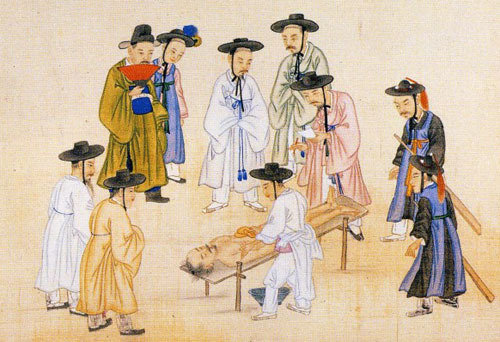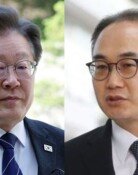Forensic investigation in the time of Joseon
Forensic investigation in the time of Joseon
Posted January. 22, 2018 07:37,
Updated January. 22, 2018 08:38

In a case of murder during the Joseon Dynasty, a county magistrate assumed the role of a medical examiner but he did not perform a postmortem inspection. It was a tough job to handle dead body and it required expertise to read scars of the body. The actual inspection was done by an expert called ojakin. The inspector found the cause of death based upon Muwonrok, an annotation of forensic medicine book. The book was originally native to the Yuan Dynasty in China, but according to the domestic situation, it had been revised several times to Shinju Mowonrok by King Sejong and to Jeungsoo Muwonrok by King Yeongjo and Jeongjo. In the 19th century, there was a publication of Geomgo, which summarized the methods of inspection and document writing.
The postmortem inspection was basically performed twice, and occasionally three times. They would even exhume a corpse that had already been buried to examine the body. At every inspection, other officials were accompanied by ojakin for objectivity. Even if it was a dead body, damaging or mutilating the body was a taboo. Since autopsy was not allowed, ojakin closely examined the condition and scars of a dead body while utilizing a variety of examination tools to identify the cause of death.
There were 10 examination tools. The vinegar was sprayed on the weapon to find the bloodstains. The rice wine lees were used to wipe the wound to reveal the scars clearly. The silver ornamental hairpin binyeo was put in the mouth or anus to check if the color changed and the white paper was put on the eyes, nose and mouth to see if the body had been poisoned. Danmoktang, boiled water with juniper trees, was used to clean the body and the roots of ovate-leaf atractylodes were used to burn off stench.
The inspection played a crucial role in resolving a case. In May 1904, there was a report to the government office by a nobleman named Ahn Jae-chan who lived in Mungyeong, South Gyeongsang Province, that his wife Hwang had hanged herself. Ojakin Kim Il-nam and the county governor together performed an inspection. There was no color change after the silver Binyeo was put in Hwang’s mouth, but were sharp scars from beating all over the body. There was a mark of strangling in the back of her neck. The inspectors concluded that Hwang had been strangled to death, not committed a suicide.
What had actually happened is as follows. A man named Jeong I-mun of the lowest class, who lived in the same village, ran away after trying to rape Hwang. When Hwang’s husband Ahn ran after but missed Jeong, he caught and beat Jeong’s grandfather. Jeong’s grandfather said that Hwang and Jeong had been in a relationship for a long time. Ramping and raging in a great fury, Ahn beat his wife and strangled her to death with a snare.
As ojakin also took care of the body who had no connection whatsoever, there was a rumor that ojakin cut and sold the body when a damaged body came out. They were despised for the sole reason that they touched the dead body, but thanks to them, a dead man who can tell no tales, sometimes cleared one’s skirts or rehabilitated oneself.
Jong-Yeob JO jjj@donga.com







